The shortest distance between teaching and learning is relationships.
The AI in Education conversation is nuanced, but among the bullet points within bullet points, there's one constant in bold italics (even underlined sometimes, ew):
We value the human element of teaching.
We trust AI to make our workflows and economy more efficient, but we don't trust it holistically to prepare the very workforce (read: people) that will be leveraging it. That’s not coming from educators. It’s coming from the students, themselves. I love that.
A world that values production and purchasing of things somehow inuits that preparing young people to participate in that world requires authentic connection. College students want to be seen and understood through feedback just as much as K12 students. The fact that that desire is coming from the students themselves is worthy of applause.
Teaching and learning are relational. They require understanding, real-world problem-solving, and productive struggle. All three of those are hard for fully-formed adults, so of course it’s hard for students. The one factor that makes it a bit easier and a lot more meaningful is someone to cheer you on, someone to point you in the right direction when you’re lost in the woods of your own confusion, someone who simply acknowledges your confusion. We all need to be seen, especially in the learning journey.
Learning is a human endeavor at its core, whether you’re a K12 student, in college, or writing Substack articles instead of putting the dishes away.
The Nuance
Educators want to feel valued by the very society they are preparing students to contribute to. There's too much to do and not enough time or pay to do it. As much as society reveres the role of a teacher and loves to make an inspirational movie about it, our policies and budgets speak differently. Left to their own devices, teachers need to make tough decisions about how to spend their time. In school, that is the most limited resource teachers have.
Enter AI. Somewhere.
As easy as it is to say that AI will improve businesses and the bottom line, it’s just as complicated to say where and how AI fits into education. School is an industry. A complex one. Teaching and learning are the primary component of that industry, but in any one district, there could be thousands of employees performing myriad jobs in order to keep that system running.
If we were to isolate teaching, though, and look to implement AI, a simple question pops up without me even having to think:
Which part of teaching are we talking about?
Teaching is much more than helping students co-create meaning out of problems, pages, or projects. It’s managing behavior and learning the nuance of individual students and whole classes; first period English on Monday is a completely different class than fifth period on Friday, even if the students are the same. It’s helping students understand how to work with their best friends and worst enemies to try and get something done. It’s checking in on how soccer tryouts went because A) you care and B) it directly affects how that student will be showing up today. It’s grief counseling on the morning of bad news. It’s life coach. It’s mini-decision maker hour after hour.
Helping students build deeper relationships within themselves, with the world, and with each other is an extremely complex task filled with many different to-do lists. The subject area is just one aspect of it. And not even the most important one.
The Confusion
The NYT article from which I grabbed the screenshot above is 9 days old. I’d been meaning to read it more closely since it was published, but just didn’t get to it (or this). Life, ya know?
So when I searched “AI Education NYT” to get back to it, the search results spoke to the confusing, contradictory landscape of AI in Education.

AI is the worst. But it’s also the best. But also the worst? No, the best? How about we just worry and call it a day?
The Decision
AI in Education is a dilemma. It’s a massive group project that involves children, adults, school systems, public policy, budgets, local and national politics, and EdTech profits. Oh yeah, and the future.
The ones who are going to figure out how to best leverage AI to help students better understand themselves and the world are the teachers. That will take time because, well, it does. Learning is not jumping to the answer, it is creating meaning out of the process so that the answer makes sense. Figuring out AI in Education is a learning process.
In the meantime, teachers will be building relationships and helping students feel seen, heard, and understood.





I think we are all still figuring this out. I agree, that the teachers who learn who to leverage and teach it to our students will lead the way. My daughter is about to enter Public School, and I am eager to see how they integrate AI learning into her education in the coming years.